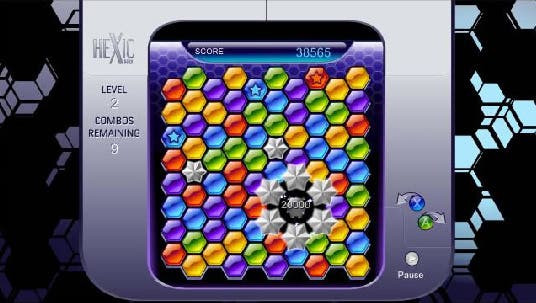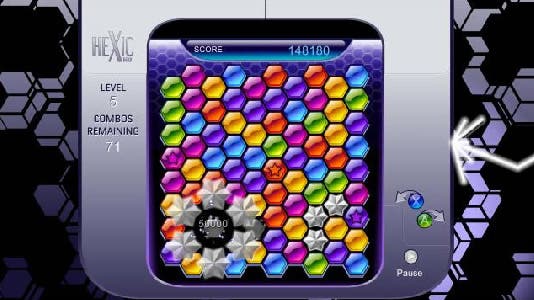Hexic HD
Turn turn turn.
You can't blame the general sense of incredulity that accompanies any discussion about the relative merits of the Xbox 360 Live Arcade. As several people are quick to point out, not unreasonably, it's a bit odd to shell out all that money for a brand new next generation console and then spend tens of hours hooked on cheap retro titles - most of which have been available on the PC for yonks.
Then the counter argument kicks in about how cheap these games are, their terrifyingly addictive qualities, and how the high score tables and Gamerscore points give an indefinable incentive to keep coming back to them.
But it goes deeper than that.
As many wise old farts point out in these moments of chin stroking pontification, they really don't make them like this anymore. The simple ability to just pick up and play a game and understand the rules, the control system and the concept in the first few seconds is an intoxicating feeling. For many of us, it was these qualities that got us into games in the first place, so it follows that getting back into games with a quick fix mentality was never going to be hard. Especially if they're good, which - let's be honest - most of the Live Arcade line-up is.
No rush

Sensibly, Microsoft offers free downloadable demos of the entire line-up, but in Hexic HD's case, it comes pre-installed for those of you who shelled out for the Premium pack, making this review less of a buyer's guide, and more of a straight discussion of the game itself.
Designed by Mr Tetris himself, Alexey Pajitnov, Hexic is yet another beautifully simple title rooted in the principles of matching three tiles of the same colour to remove them off the screen. No surprises there, but unlike the manic pop thrills of Bejeweled 2 or Zuma Deluxe, there's far more of a slow burn, strategic nature to it - probably more so than almost any other puzzler we've played.
As the title suggests, this one's all about manipulating hexagons, which immediately lends completely different mechanics to the game than simple square-tile-swapping or bubble-popping. Blessed with only the ability to rotate a cluster of three connected hexagonal tiles clockwise or anticlockwise, you must try and join up three tiles of the same colour to get them to hexagon heaven (most likely), with more tiles raining down from above to fill the void. Sounds simple enough, and to begin with it feels like you'll succeed by moving practically any cluster on the board.
Sure enough, though, there's much more to Hexic than initially meets the eye, with the real challenge barely even apparent for some time. The first things that will almost certainly finish you off are the bombs that start appearing a few stages down the line. Given only a few turns to safely get rid of them, you have to swiftly and skilfully manoeuvre the bomb into a cluster of three - not always that straightforward once the number of different coloured tiles starts to increase later in the game. Failure is severe, with just one slip up resulting in the appearance of the dreaded Game Over screen.

Dealing with bombs is one thing, but actually getting a decent score is something that'll probably elude most players entirely without serious practice. The key here is to become adept at making what's known as a 'Starflower', which is essentially gained by surrounding one hexagonal piece with pieces of another colour on all six sides. Not only do you get a whopping points bonus for it, but the special piece that's left behind can be used to rotate all the pieces around it, making it possible to shift pieces in a completely different way.
Building up from one Starflower, if you can somehow manipulate the board to make even more of them, the really big points become available. Creating a cluster of three Starflowers certainly helps, but arrange six of them in a Starflower arrangement and you create a Black Pearl - the holy grail of Hexic. If you get that far, however, you're doing exceptionally well and deserve some sort of medal; if fact, creating a cluster of three Black Pearls actually wins the whole game, but few souls in the world have managed that.
Fortunately, there are more straightforward ways to play Hexic than the awesome time-sink that is the Marathon mode. Survival mode, for example, is a straightforward case of trying to clear a single board. No more pieces fall down from above, and after each of the 50 rounds those left behind become 'locked' (i.e. you can no longer move them) until you can free them again by forming a three-strong cluster or other cunning combos. If the whole board becomes bunged up and locked, then it's Game Over, otherwise you keep going until 50 rounds have been successfully negotiated.
Finally, the Timed mode removes the slow-paced nature of the Marathon mode by forcing you to get a move on, but also makes your move-making far less strategic and therefore much riskier and less points oriented. If you're feeling particularly brave, even harder skill levels ramp up the challenge, but only do so by jumping to later levels which seems a little pointless.

Regardless of what mode you choose, though, the random nature of Hexic means that it's possible to be dealt a really unfortunate 'hand' during the least appropriate moments. The appearance of bombs, for example, can be particularly galling when it's obvious that getting rid of them is nigh on impossible thanks to the arrangement of pieces. In particular, the fact that one unfortunate mistake or twist of fate ends your game seems unfair to say the least. When it keeps happening, it may well rob you of your will to continue, which is a shame as the core gameplay is addictive and rewarding.
While all of your head-scratching, twisty-turny adventures are going on, the one thing that keeps you sane is the mesmerising ambient soundtrack that bloops away serenely in the background. Not only does it sound a world away from the staple repetitive ditty we're normally forced to endure, it's surprisingly palatable given the context. More of it, please.
Needless to say, the 'HD' moniker attached to Hexic guarantees that the game looks utterly pin sharp on a high definition set, but it's fair to point out that you won't exactly be rushing to show it off to your mates as a stunning example of next gen display technology. But really, who cares about the visuals in games like this? If anything it serves as a reminder of how little the graphics matter when you're wrapped up in something you enjoy.
As an introduction to the joys of Live Arcade, Hexic HD isn't necessarily the most riveting example of what's on offer in Microsoft's ever-expanding line-up. Compared to some of the other titles now available, it's a real slow-burn experience, and not really the sort of game where you can have a 'quickie' (once you get going, games lasting a minimum of 30 minutes are the norm). But if you're in the mood for one of the more cerebral, calming puzzle experiences around, you could do a whole lot worse than fire Hexic up when you're between games - if only to trounce the high scores of your buddies.

